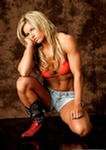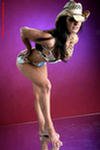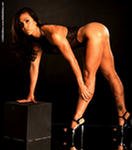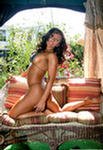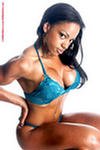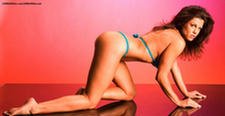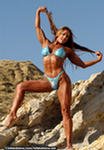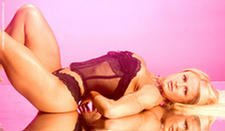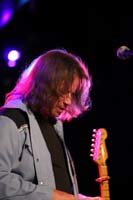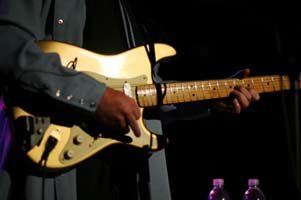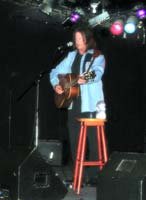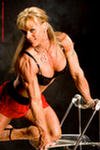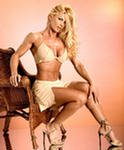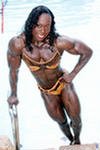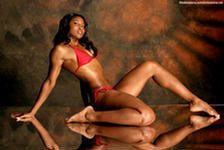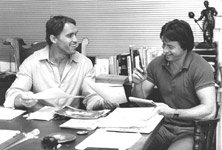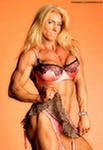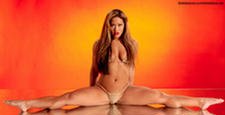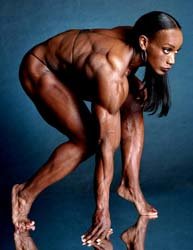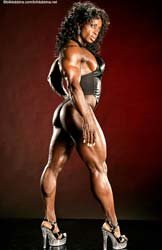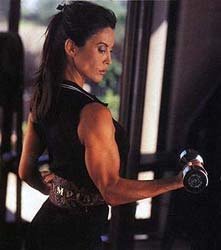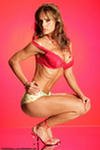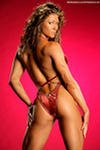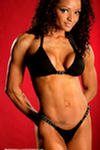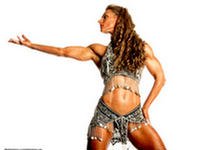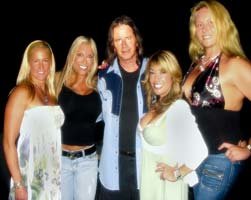The natural beauty inherent in the female bodybuilder's physique is captured at its best through the photographic lens of one of bodybuilding's most vocal pro-women's bodybuilding advocates, Bill Dobbins.
Anyone who has read two of bodybuilding's most widely circulated magazines, Flex and Muscle and Fitness, especially throughout the 1980's and '90s, might recall Bill's stunning, creative images of beautiful female bodybuilders that graced many a page.
Today, and much to Bill's chagrin, women's bodybuilding coverage is almost non-existent; such is the perceived lack of marketability these physiques have, among other things.
However, although media coverage of women's bodybuilding has lessened, there is still a tremendous amount of respect and appreciation shown for the muscular female form as exemplified by the popularity of websites that feature female bodybuilders.
Naturally Bill runs the best of these websites and this is where much of his work can be seen these days. Although Bill has spent much of his career specializing in photographing the female physique it would be a mistake to assume that he has limited his expertise to this aspect of the iron game.
Along with bodybuilding photography, Bill has also contributed to various physique magazines through the many articles he has written. He has also authored and co-authored several books including the landmark bodybuilding text Arnold Schwarzenegger's Encyclopedia of Modern Bodybuilding, both the original and updated versions, and his own highly successful, The Women: Photographs of the Top Female Bodybuilders.
As a 12 year old Bill began his love affair with photography and music, passions that have endured to this day. He added bodybuilding to the list when he began training at the original Gold's Gym in the early '70s after which he began working for Joe Weider as Founding Editor of Flex magazine.
His musical interests sparked a career for him as an American folk singer by age 17 which led to regular performances in some of New Yorks best-known clubs and coffee houses. Today he writes his own music with a view to recording.
Having spent the best part of his life working in the bodybuilding industry, and using his talents to improve various aspects of it, Bill has met his share of interesting people and has had many enjoyable experiences along the way.
He is noted for contributing to the growth of female bodybuilding through his photography, articles and administrative support in running women's bodybuilding contests (he wrote the original set of competition rules for female bodybuilding for both the IFBB and the NPC).
Bill also has a background in production and broadcasting which was used to great effect when he promoted and ran the 1977 Mr. America, which featured, among other things, Bill Grant riding an elephant through Santa Monica while hitting double biceps shots. In the 1990s Bill became head of Weider communications and was responsible for creating the 10 volume video collection of the Weider Principals, a set that has just been released on DVD.
Today Bill continues to promote women's bodybuilding while battling the bureaucracy that prevents the female physique from achieving the degree of respect it commanded in the '90s.
Bill has also fought a battle of another type: he has been receiving treatment to overcome a lymphoma that was discovered earlier this year, a variation of the same disease he was treated for in 1995. For his current lymphoma Bill will receive six chemotherapy sessions in an effort to overcome this cancer. The outlook at this stage is very good.
I contacted Bill recently to learn more about his current situation, his role as a pioneer for women's bodybuilding, and his many careers.

Interview

[ Q ] How did you get started in photography?
When I was about 12 years old I got interested in two things: photography and music. A friend of mine belonged to a photo club with darkroom facilities and he showed me the basics of developing and printing BW (black and white) photos.
I kept up my interest and was a school photographer in both high school and college. When I was still a teenager I went to live for 3 1/2 years in Europe where pursuing photography was difficult but doing music was easy. So I pretty much put photography aside for a number of years until I began working for Joe Weider as a writer.
I quickly realized that the photographers at Weider made a lot more money than the writers so I began working to recover and develop my photographic skills.
Photo Shoots:

[ Q ] Over the years you have specialized in bodybuilding photography and women of the iron sport in particular. What attracted you to using female bodybuilders as models?
- That there was something very special about bodybuilding for women because this was the first time in all of history that women were developing their muscles for aesthetic purposes (with incredible implications regarding our understanding of the potentials of the female body as well as many other health, cultural and social issues); and...
- The female bodybuilders were not only facing opposition from the public because what they were doing violated strongly-held preconceptions regarding body morphology and gender identity but were also being subjected to unfair gender discrimination by the bodybuilding federations themselves.
I was writing about and shooting the men when female bodybuilders began to compete. My experience in sports is that there are many of them in which men and women both compete - tennis, golf, track, basketball and so forth.
I quickly accepted the fact that bodybuilding was now also a sport in which men and women both participated and I started covering the women as well. But two things became apparent:
All of this, plus the fact that most other photographers and most of the magazines were not concentrating on these women, lead me to realize that this was a very important subject that was worthy of my giving it a lot of attention.

[ Q ] What other areas of bodybuilding have you worked in and how did you get started in these? What was your initial inspiration for each?
In the 1970s I moved into a house four doors away from the original Gold's Gym. I started working out there, began doing promotion and publicity for the gym, staged the 1977 Mr. America contest for Gold's, which brought me to the attention of Joe Weider, for whom I started writing.
Joe eventually gave me the job of founding editor of Flex Magazine and I continued to work, as a writer/photographer/editor for the various Weider magazines for many years afterwards.

[ Q ] In your multifaceted career you have also worked in broadcasting. What attracted you to broadcasting and how far did you choose to take this career?
I was playing in some of the top clubs and coffee houses in New York such as Gerde's Folk City, The Gaslight Club, The Bitter End, Café Wha? and others. But the folk era was ending, I was then writing songs as they fit the changing times but the industry had grown to the point where it was hard to survive without moving up to making records and touring nationally.
Through some people I knew I had a chance to work in broadcasting (my second job was a director at WABC - the top rated station in the top market in the U.S.). I was concerned about putting all my eggs in one basket by doing nothing but music and so I decided to have a trade to fall back on.
When I first moved to California I started working as a producer at the local Westinghouse all-news station (and later for a while for Westinghouse TV) and this allowed me to help Gold's Gym with publicity, which got me involved in the whole bodybuilding/fitness industry.
Editors note: Café Wha? is located in Manhattan's Greenwich Village and has been home to many of the music and entertainment industries major recording stars, including Jimi Hendrix, Bob Dylan, Bruce Springsteen, Kool and the Gang and comedians, Bill Cosby and Richard Pryor.

[ Q ] You also moved to France at the age of 17 to work in photography, but instead initially became a singer/songwriter. Tell me more about this. Why the move to France?
My father was a military pilot and when he was stationed in France I was able to travel to Europe for free. I was an avid reader as a kid and I went to live on the Left Bank of Paris with images of writers like Ernest Hemingway and artists like Picasso and Mattise in my head.
 |
The Left Bank: A district of Paris on the southern, or left, bank of the Seine River. It has long been noted for its artistic and intellectual life. |
 |
 |
||
Being an American folksinger at that point gave me entrée into a lot of circles and when I later moved to Munich, Germany, I was able to earn money singing mostly at a variety of military clubs.

[ Q ] Tell me more about your music career.
This is such a long story that I have created a music biography on my music site at www.billdobbinsmusic.com - separately from my overall bio on my photography site. The main problem I had in music is that I went to live in Europe just at the time when the whole folk boom was happening back in the U.S.
I actually got to NY shortly after Bob Dylan, but he stayed there and I left for four years. When I got back the industry had changed and the opportunities were not available to the same degree. But I had a lot of adventures, singing at historic clubs, traveling up and down the East Coast to do gigs, working with legendary performers like Emmylou Harris, Arlo Guthrie, Phil Ochs, John Hammond, Ramblin' Jack Elliott and others.
I also either met or ended up in the same room as all sorts of famous artists that included Dylan, Joan Baez, Kris Kristofferson, Sonny Terry and Brownie McGhee, Carolyn Hester, John Denver, and groups from The Fugs to The Mothers of Invention.
| RELATED ARTICLE | |||
|
Author: Brenda Kelly |

[ Q ] What are your recollections of Bob Dylan from the limited time you spent with him?
I knew somebody at Columbia Records who was working with Dylan on one of his albums. I ran into him on the street outside the record company and we talked for a while. It turned out he was waiting for Dylan to arrive. Dylan showed up and my friend made some kind of perfunctory introduction, pretty much just pro forma, Dylan and I both nodded and then they walked into the building.
Over the next few years I occasionally saw Dylan and his wife at local clubs or bars but they pretty much kept to themselves and I never had occasion to talk to him.
But one evening I was due to perform at Izzy Young's Folklore Center on 6th Avenue along with Tim Buckley, who was making his NYC debut, when somebody came up to me and said, "Did you hear that Bob Dylan is furious with you?" I said I didn't but hoped it was true since that could help me have a real career. I don't think it was true since I never heard anything else about it.
A couple of years ago I arrived at LAX with a lot of photo equipment and was waiting outside for my ride. I saw another pile of equipment just a few feet away with nobody around it. I looked around and there, standing up against the building, was Bob Dylan - considerably older than the last time I'd seen him.
Nobody else recognized him. Soon a girl showed up in a van and gestured to me. I think she thought my stuff was Dylan's. I pointed over to where Dylan was standing, she nodded and I guess they loaded up the van and left. My ride showed up at the same time so I didn't really pay attention.
The last time I saw Dylan was in concert here in Los Angeles, on a bill with Merle Haggard. Haggard was great but I was disappointed in Dylan's performance. He seemed to have given up any attempt to really sing and just growled out the words. He was half way through "Maggie's Farm" before I recognized what the song was so I had no clue as to the lyrics of his new compositions.
He played keyboard, not guitar, never looked at or talked to the audience and the arrangements for the songs seemed pretty similar to me. I like some of the cuts on his new album but as he pointed out in a recent interview he has no idea where his music from the 60s came from and he certainly can't work at the same level now. Of course, having done so much there is no reason to expect him to.

[ Q ] I understand you trained at the original Gold's Gym in Venice, California. What was it like training surrounded by the likes of Arnold Schwarzenegger and Franco Columbu?
There are animations that show the earliest mammals as tiny creatures scurrying around to avoid being stepped on by huge dinosaurs. That's what I felt like when I first started working out at Gold's. The original gym was quite small so if I wanted to train when the big guys were there I had to watch out for opportunities to use the equipment without getting in somebody's way.
Nowadays, when people tell me they are "intimidated" by working out in gyms where top bodybuilders train I have trouble being very sympathetic. Try being a pencil neck and going to Gold's in 1976 and you would realize what intimidation really means. But, in fact, after a short time I became accepted, especially when I started working for Joe Weider and could get bodybuilders coverage in Muscle & Fitness and Flex.

[ Q ] Do you have any stories to share of your time training at Gold's in the 1970s?
One incident that stands out happened on Halloween evening just before the bodybuilders were about to leave for the Mr. Universe in South Africa that is depicted in the movie Pumping Iron. I was out by the alley behind my house (and behind Gold's) at dusk when a Corvette rounded the corner and began to accelerate at high speed. There were kids out trick-or-treating so I yelled at the driver to slow down.
The Vette suddenly braked and out got Ken Waller, a bodybuilder known for his temper and one of the few who actually got in fights on a regular basis.
He started walking toward me yelling threats and screaming that he put pencil necks like me in the hospital. But he had left the car running and the further he got away from it the slower he moved.
At one point he just stopped, went back and got into the driver's seat and roared off. Ken didn't seem to recognize me from the gym, but I went to a "carb party" at his house after the Universe; he probably had forgotten the incident by then and we got along great from then on. But I can tell you that Ken Waller is NOT the guy you want setting out to beat you up.

[ Q ] Ken was an interesting guy in more ways than one it seems. Do you have any more Waller stories?
Here's one David: Kent Kuehn, one of my first training partners, married Roy Roger's granddaughter. At the reception the bride got ready to throw out her garter. Supposedly, the guy who caught it would be the next to be married.
Ken hung back but his girlfriend kept teasing him. So just as the bride threw the garter out Waller stepped forward and, fast as a snake, snapped it out of the air before anyone else could reach it. Ken was not only bigger, stronger and - when in the mood (only sometimes) - meaner than anyone else, he was also a superb athlete.

[ Q ] You also promoted and then staged the 1977 Mr. America. Describe the challenges inherent in this major undertaking?
If you look at videos of bodybuilding contests in the 1960s and 1970s you will see that a lot of them were not produced very professionally. Lots of top-level shows were held in places like high school gyms. Gold's wanted to put itself on the map with the 1977 America.
The show was preceded with a parade through Santa Monica (the second largest specialty parade in Los Angeles for the year) that featured, among other things, Bill Grant riding an elephant and hitting double-biceps shots.
I had done some rock concerts back in New York and I used the same production structure as I had before - I had a staff that included a stage manager and sound and lighting directors. I worked out a 5-page schedule that detailed exactly how the event would be conducted. This was the contest you'll see in photos that had a huge American flag behind the competitors and a live orchestra on stage.
We gave out 500 press credentials that included a lot of mainstream organizations like Time Magazine. I spent a lot of my time going back to the stage door and identifying VIP'S who wanted access but who weren't on the list.
One of the biggest problems involved trophy presenter, Mae West. She refused to come out of her dressing room as long as there were any photographers backstage on that side. It took me probably 20 minutes to convince everyone that they had to leave. But they finally did and the show ended up taking place flawlessly, with no problems.
What surprised me at the time, but doesn't now that I know the industry better, is that in spite of having done such a good job staging the event, nobody ever asked me to do another one. Farsighted thinking is not the first thing you think of when it comes to the bodybuilding/fitness world.

[ Q ] One of your larger writing projects may have been your collaboration with Arnold on his Encyclopaedia of Modern Bodybuilding. What did you like most about this process and what was it like working with Arnold in your capacity as a writer?
Each book I did with Arnold was different. The first, Arnold's Bodybuilding for Men, was pretty basic. Arnold always goes over every project carefully but he was pretty much satisfied with how I translated his instructions into a book.
The first Encyclopedia of Modern Bodybuilding was quite different. I met with Arnold many, many times. I had worked out a chapter outline and he would dictate what he wanted in each chapter and give me a lot of his observations and personal anecdotes.
I would write the chapters, combining my ideas with his, give him the pages and he would go over them again, using a tape recorder to dictate what changes or additions he wanted. This was a long, time-consuming process and it ended up combining everything I knew about training and diet I had learned working for Weider for many years, plus everything from Arnold's experience that he wanted represented in the book.
The second Encyclopedia was more problematical. I got very little direction from Arnold at the beginning, very few meetings and just general instructions that the book needed to be "updated" to reflect new ideas, information and trends in bodybuilding.
When I finally met with him at his office after finishing the first draft - thinking we were just going to do a final edit - I saw that he hadn't even opened the envelopes containing the pages I delivered.
At that point Arnold finally began to concentrate on the book - and when he pays attention he REALLY pays attention - so I ended up having to do a total rewrite. The problem was that we were up against the supposed deadline for delivery of the book - which became impossible to meet.
Instead of giving Simon and Schuster a manuscript in March or April I ended up giving them material in November, just before the book was actually printed. Of course, the new Encyclopedia turned out great in the end - but the extra six months of work and constant pressure was no fun and didn't do much for my relationship with Arnold - at least, not at the time.

[ Q ] How would you describe your working relationship with Arnold and what were some of his key positive attributes, attributes other than what you have already discussed?
Arnold is one of the neatest, most organized people I've ever met. Whenever I used to go over to his duplex when working on the first book, it always looked as if the maid had left. When he finishes working on one project he gathers up all the materials and puts them away before turning his attention to working on something else.
Working with Arnold hasn't made me neater but it has taught me the truth of the saying "Seeing through the game is not the same as winning the game." The so-called "artistic" mind is prone to try and understand what the underlying reality of a situation is. Arnold is more interested in understanding the literal reality and figuring out how to achieve his goals in any given situation.
| RELATED ARTICLE | |||
|
Author: Matt Weik |
I've actually written several versions of an article about "How Arnold Thinks" that was on the money enough that Arnold himself congratulated me on my insight. But people have also asked me if Arnold was "nice" and I've always said that is not an appropriate word to use in describing him.
He could be charming and funny or become an Alpha Male and take over any situation - but nice people are comfortable to be around and Arnold rarely was. But I suspect now that he has had to deal with people on a different level as a politician, plus he is a devoted father with a houseful of kids, that he has become a lot "nicer" over time and is probably easier to relax and spend time with at this point in his life.
And Arnold Rarely Was."

[ Q ] What writing and photography projects are you most proud of and why?
I suppose my most outstanding achievements involve being able to have two international art books published. The first was The Women: Photographs of the Top Female Bodybuilders (Artisan) and Modern Amazons (Taschen). Of course, on a day-to-day basis being able to maintain two female physique websites (The Female Physique Webzine/Gallery - www.billdobbins.com and The Female Physique Art Gallery - www.billdobbins.net).
I have more than 100,000 photos on these sites and they are the only source I know of for seeing this many quality photos of female bodybuilders, fitness and figure competitors.
You certainly can't count on the physique magazines to publish photos of beautiful muscular women. They are printing mostly shots of so-called "fitness models," their reader base is shrinking and the one has something to do with the other. People like looking at beautiful bikini models but they don't want to pay for them. Just ask FHM magazine, which recently went out of business.

[ Q ] What is the most enjoyable aspect associated with photographing female bodybuilders?
-
Of course, spending time with these women is itself enjoyable. The women are generally much nicer to work with than the men. And it's satisfying to be able to come up with types of photos that have never been done before because this type of physique has never existed before. But, in addition, I think what these women are doing is historically, culturally and scientifically important.
Because of bodybuilding training, women in general who are in their 40s can now have bodies 10 or 15 years younger. Women bodybuilders have paid a price being pioneers but they have helped to revolutionize our culture - as have the men.
I just wish all of them got credit for the changes they have made to health, fitness and exercise rather than being denigrated because they get singled out on the drug issue - in spite of the fact that anabolics are widespread everywhere from Middle School to the top pro athletes. That train has left the station and it's about time the public, government and sports realized the truth of this and stopped focusing on bodybuilders.

[ Q ] But what would you then say to someone who feels steroid use among male bodybuilders is justified on the basis of them being male and the fact they produce greater quantities of testosterone naturally, while women should not take steroids because hormonally they are less suited bio-chemically to these substances?
- Steroid Temptations. - By Myron Mielke
- The Drug Debate. - By David Robson
- Your Feelings About Steroids In Sports? - By Athletes Topic Of The Week
- Anabolic steroids didn't work, then
- They worked but were highly dangerous and finally
- They work, aren't really that dangerous but using them is cheating.
First of all, in a world full of "conspiracy theories" about everything from UFO's to the Kennedy Assassination, the only vast conspiracy I believe in is the one involving anabolic steroids. Any expert who has actually studied the subject knows that steroids are not as effective as the media makes out and, in most cases, not nearly as dangerous. But they are as afraid to speak up as were those back in the 1950s that knew the U.S. Government and Hollywood were not being overrun with communist agents.
Steroids:
In reality, athletes benefit from all kinds of "unnatural" supplements (try to find natural free amino acids, for example), spring-loaded running shoes, faster tracks and swimming pools, high tech tennis rackets and golf equipment and all sorts of advantages that could well be described as "cheating."
An athlete can legally take cortisone (a steroid) to reduce inflammation but sports authorities (mostly the IOC) decided way back in the 1960s that:
So the discussion about and laws covering anabolic are so screwed up; just don't get me started! As to the biology of females, when you point out that women have very little male hormone in their bodies compared to men the actual conclusion should be (and is) that this means they get a lot of anabolic benefit out of very low doses of steroids, doses well below the threshold that produces androgenic (masculinizing) effects.
However, since neither men nor women are able to take anabolics under the supervision of a physician, who could give them blood tests to monitor what they take and the dosages, there is a constant danger that any athlete using steroids is liable to take too much of the wrong thing and experience unwanted side-effects.
It was true when the 18th Amendment to the Constitution banned alcohol and it's true of the drug laws today - DRUG PROHIBITION MAKES DRUG ABUSE WORSE. Always.

[ Q ] Point taken. Who was the most visually appealing female bodybuilder you have worked with and why? What made her a good model?
I've done excellent photos with a lot of top physique women. Certainly the photos I've done with Lenda Murray are among my best, in part because Lenda has such a shapely, aesthetic physique and also because she is so easy to work with.
Among current competitors, Dayana Cadeau is among my favorites. She has such a full, shapely physique that it is easy to get outstanding photos of her. In fact, this actually works against her in some ways because few magazines will run photos of her. At 140 pounds or less she just looks too big in pictures - at least too big for most magazine publishers and art directors.

[ Q ] You were also active with the IFBB and appointed by Ben Weider to be the first liaison to female bodybuilding. What exactly did this appointment involve?
Mostly this appointment involved a lot of grief and frustration. Ben was never really behind the women as actual bodybuilders. He liked them when they were smaller and more conventionally acceptable such as in the case of Rachel McLish.
He also had the idea that women should be in charge of women's sports (a gender discriminatory concept) and he tended to appoint women who would mostly follow his instructions and weren't in favor of "the girls getting too big."
The first was Doris Barrilleaux, a flight attendant from Florida, who was (ironically) brought to his attention by an article I did that included her called "Muscles Amid The Magnolias." Doris immediately did everything she could to keep me from having any influence. She then decided that the lat spread had no place in female bodybuilding ("Women don't have lats anyways," she said, along with "I don't like it.")
| RELATED ARTICLE | |||
|
Author: Bill Dobbins |
It took until just a few years ago to get the NPC and IFBB to restore this pose. And this happened so smoothly that many don't remember that the pose was left out for some 20 years. Doris has since decided she is the First Lady of Bodybuilding and one of the founders of weight training and bodybuilding for women, but she and a number of other "officials" appointed by Ben over the years were, unfortunately, part of the problem rather than part of the solution.

[ Q ] Describe the process of writing the original set of competition rules for female bodybuilding for both the IFBB and the NPC?
I took my cue from other sports in which the rules for men and women are the same unless there is some need to make an exception. Women golfer's, for example, play using the same rules except the holes are shortened to preserve the concept of par.
Women tennis players are governed by the same rules as the men only they play three set finals at major events rather than five sets due to the length of the average game in their matches compared to the men (who serve more aces and engage in fewer and shorter serve-and-volley exchanges).
The first rule of the ones I created stated that the same rules for women would apply as for the men unless there were specific exceptions made. There were supposed to be very few exceptions.
One was that women wear tops while men don't. That conforms to a virtually universal practice in our culture. But the women chosen to administer the sport didn't read the rules very carefully. There was one example of a competitor winning the equivalent of the National's overall (it was an AFBW contest I think) twice.
Because Nationals overall winners can't compete again in the NPC the same rule applied to the AFWB, as it does now among women in the NPC. This error is just another example of the practice of appointing officials in women's bodybuilding for political reasons rather than based on their competence.

[ Q ] What are your thoughts on the current state of women's professional bodybuilding?
The female bodybuilders are subject to less pressure since the inception of fitness and figure contests. Judging in bodybuilding is rarely perfect but the results at recent Olympia's and Ms. Internationals have been pretty accurate. But the pro women are not getting magazine coverage, which means they have trouble getting guest posing jobs and sponsorship.
The industry as a whole doesn't promote them and this ends up costing everybody money, since making stars out of at least some of the female bodybuilders could help sell products and magazines.
One problem is that so many women who should be in bodybuilding have opted to go into figure instead. Big mistake. Nobody with true bodybuilding genetics will ever excel in figure (the exceptions being those who get ahead due to prevalent corrupt political practices). Nor are they likely to have careers that last as long as do those of the top female bodybuilders.
Actually, given all that is against them I am still surprised that so many women are still deciding to become bodybuilders. It just proves that bodybuilding is as much a "fundamental" sport as are the ones that involve running, jumping, throwing, lifting and so forth. If they do it despite the opposition, you know they can't help it - it's "in their blood."

[ Q ] How could women's bodybuilding be improved then?
First, the federations should simply accept that bodybuilding is bodybuilding and stop trying to limit the development of the female bodybuilders. There is a mechanism for weeding out competitors who are too big, thick or bulky for their frames. It is called "aesthetics" and this applies as much to the women as to deciding whether Jay Cutler or Ronnie Coleman should win the Mr. Olympia title.
Second, I would hope more of the magazines would realize that there is an audience for these women and that by including at least a few quality photos and articles on them in their pages they would increase sales.
Also, as far as the NPC goes, while the judging is generally pretty good I have noticed that officials at the USA and the Nationals tend, in many cases, to overlook women with really pro-level physiques (competitors who could walk into a pro show and easily win or place well) in favor of smaller women they consider somehow more "representative" of what an amateur should look like. This is just stupid.
And The Nationals Tend, In Many Cases,
To Overlook Women With Really Pro-Level Physiques."
When you are deciding who should get a pro card you need to judge on the basis of who looks most like a pro and is likely to succeed as a pro. You would rarely see an NPC judge doing the same thing in a men's contest.

[ Q ] Are you currently involved with the IFBB in any way? If so, what is your role?
I have no official role. I just bug people. For example, I tried for years to get the federations to put the lat spread back in female bodybuilding. One promoter (and he knows who he is) told me, "The NPC won't have lat spreads for women in my lifetime." He is still alive as far as I know.
Currently, I would like to see some kind of posing put into figure, as is done in places like Australia and New Zealand. Quarter turns are not only boring but they don't show as much of the physique as would some aesthetic poses.
I have also never figured out why you cover up an athletic physique with a one-piece posing suit. That's another stupid idea. Let's have a posing round instead, with the women wearing two-piece suits that show their torsos. However, while I've put those ideas out there I don't really work as hard for fitness and figure as I do female bodybuilding. It just isn't worth it.

[ Q ] What other projects are you working on these days?
I'm getting back into making videos. I was in charge of Weider Communications at one point, which produced the Weider System and the Weider Video Library. I'm setting up to do both video clips and HD DVDs sometime soon.
I want to do another photo book only to design it myself and to include text throughout the book along with photos. And, of course, I am making demos of my songs for my www.billdobbinmusic.com site and perhaps getting the songs published in the near future.

[ Q ] Doing what you do on a regular basis must take its toll mentally and physically. What do you do to relax and get away from it all?
I don't take much time off. But one way I decompress is riding motorcycles. LA is unusual in that it is built in and around a lot of mountains. You have to go over or around these mountains to get to various parts of the city.
At the edges of the greater-LA areas, built right up against the wilderness (one of the reasons for having so many destructive fires) people often find deer, elk, bears and sometime cougars in their back yards. Because of this there are hundreds of miles of beautiful, twisting, scenic mountains and canyon roads that are great for riding a motorcycle. I looked at Google Maps recently and found there was only one such twisty road in the areas I hadn't ridden on - and that starts nearly 40 miles away.

[ Q ] What have been some of the standout moments in your career so far? What lessons have your learned?
Between my general bio and my music bio I think I've covered most of the highlights of what I have done. Honestly, one of the reasons I have been able to accomplish a lot in different fields and develop a lot of different talents is that I don't spend much time looking back.
I know a lot of people for whom the high point of their lives and careers happened well in the past. I always think that I can look forward to bigger and better accomplishments in the future.
I've gone through a series of peaks at different times but I believe the trend of the overall graph is always upward. So I think the basic lesson I have learned is to always look forward, be happy about what you've accomplished but keep your eye on the next challenge.
The idea of "retirement" makes no sense to me. If I won the lottery and didn't have any money concerns I would still be doing some variation of what I'm already doing now.
| RELATED ARTICLE | |||
|
Author: Bill Dobbins |

[ Q ] I understand you are currently undergoing chemotherapy treatment for lymphoma, with an excellent prognosis for a total cure. When and how did you discover you had lymphoma?
I started feeling unwell right before the USA in July. I felt some kind of pressure in the lower abdominal area and had a headache. That went away but came back in late August, along with a lump alongside my neck. I had been treated for lymphoma back in 1995 so I went back to my oncologist, he had a biopsy done that confirmed I had a variation of the original disease and put me on a program of six chemotherapy sessions, once every three weeks.

[ Q ] Could you go into more detail on the treatments you have received so far? How have they worked?
This form of lymphoma is "higher energy" than the first. This means the chemo needs to be stronger but the prognosis is for an 80% chance of total cure, with the disease never returning.
The first chemo session just about wiped out the original symptoms I had experienced but the treatments get stronger as you go along so I expect to feel a general debilitation in general and some very bad days immediately after the chemo sessions. But there will only be six sessions total and although I'll feel bad some of the time and lose a lot of hair it will all be over by the end of January and I'll be fine when the Arnold comes around in March.
| RELATED ARTICLE | |||
|
Author: Brad Borland |

[ Q ] How much of your recovery so far would you attribute to correct nutrition and your exercise regimen and exactly how has your physical health contributed to your recovery?
Being in better shape when you get sick is obviously an advantage but in my case I can't really be specific as to what the specific benefits are.

[ Q ] How important has your mental attitude been in overcoming this lymphoma? What are some strategies you used to foster the positive internal environment necessary to promote full recovery?
Having a good attitude helps to make you feel better and improves your quality of life. But recent studies have debunked the idea that attitude by itself increases the survival rate from serious illness.
Improving your overall immune system function is one thing. But a writer in the LA Times wrote recently that having a serious illness is like a freight train going full speed - no matter how many people you put standing in front of it you are not going to slow it down.

[ Q ] How did your diagnosis with cancer affect your work and overall quality of life?
The cancer itself has almost no affect at this point. But the chemo does. I lack energy some days and need to rest during the workday. I avoid scheduling any photos shoots or working on other projects for at least three or four days after a chemo session.
At this point I'm not doing any exercising except for taking walks. My view is that this situation is only going to exist for a few months and it's just a matter of getting through it and then getting back to a normal schedule afterwards.
| RELATED ARTICLE | ||
|

[ Q ] Has your diagnosis with cancer in any way influenced how you view life?
Actually, it was my first experience with cancer back in 1995 that had the biggest impact. In the beginning, as far as I knew, it seemed the lymphoma might kill me.
Being faced with your own mortality, it is brought home that, even if you survive this threat, something is going to kill you eventually. It's just a matter of what and when. Once you come to terms with that, at least in my experience, the idea that you might suffer extensively or lose your sense of self from a disease like Alzheimer's engenders more anxiety than does the idea of death itself. I will say this realization tends to make you take life a lot less for granted.
It Is Brought Home That, Even If You Survive This Threat,
Something Is Going To Kill You Eventually."

[ Q ] What advice would you give to other people faced with the same, or a similar situation to what you are faced with now?
- Effects Of Smoking And Drinking On Bodybuilders! - By Herve Duchemin
- No Drinking And Training! - By Charles (sword chucks)
- Bodybuilding & Alcohol: Do They Mix? - By David Robson
- Other Alcohol Articles...
Nobody gets out of here alive and the older you get the more chance there is that you will get sick. Certainly, living a healthy lifestyle - keeping your weight down, avoiding smoking or abusing alcohol and drugs, and exercising - reduces the chances of getting many kinds of illnesses.
Alcohol:
One other strategy is to make sure you see a doctor regularly. And a dentist: since infections in the mouth can lead to all sorts of other problems, including heart disease. If you do get sick do your best to find doctors you can trust and then do what they tell you. I can't tell you the number of people who have advised me to try "alternative medicine" remedies, many of which have long been shown not to work.
Medical science is constantly making progress. There are better chemo programs today than 12 years ago when I was first treated for lymphoma. There are better treatments for all sorts of other types of cancer, many of which are much less easily treated than what I have - such as pancreatic cancer, lung cancer, breast cancer and brain tumours - and in 10 to 20 years there will probably be much improved treatments or even cures across the board.
Don't be in denial. If you think something is wrong, ignoring it and hoping it will go away is not the answer. The sooner you find out something is wrong the better your prognosis for treatment.

